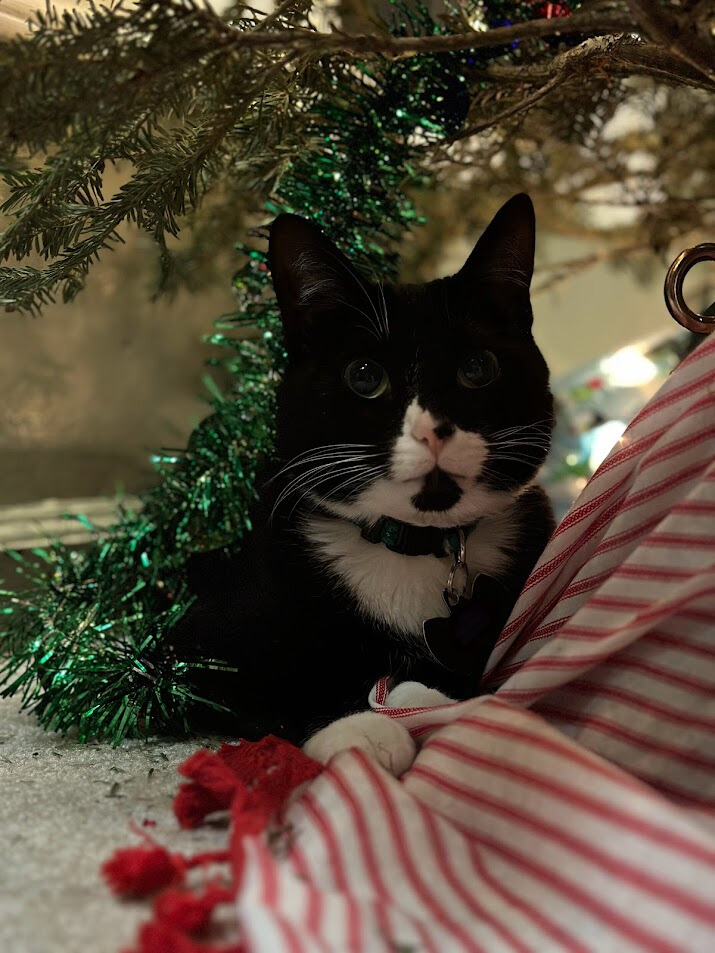Holiday Health Hazards for Pets
go.ncsu.edu/readext?1044196
en Español / em Português
El inglés es el idioma de control de esta página. En la medida en que haya algún conflicto entre la traducción al inglés y la traducción, el inglés prevalece.
Al hacer clic en el enlace de traducción se activa un servicio de traducción gratuito para convertir la página al español. Al igual que con cualquier traducción por Internet, la conversión no es sensible al contexto y puede que no traduzca el texto en su significado original. NC State Extension no garantiza la exactitud del texto traducido. Por favor, tenga en cuenta que algunas aplicaciones y/o servicios pueden no funcionar como se espera cuando se traducen.
Português
Inglês é o idioma de controle desta página. Na medida que haja algum conflito entre o texto original em Inglês e a tradução, o Inglês prevalece.
Ao clicar no link de tradução, um serviço gratuito de tradução será ativado para converter a página para o Português. Como em qualquer tradução pela internet, a conversão não é sensivel ao contexto e pode não ocorrer a tradução para o significado orginal. O serviço de Extensão da Carolina do Norte (NC State Extension) não garante a exatidão do texto traduzido. Por favor, observe que algumas funções ou serviços podem não funcionar como esperado após a tradução.
English
English is the controlling language of this page. To the extent there is any conflict between the English text and the translation, English controls.
Clicking on the translation link activates a free translation service to convert the page to Spanish. As with any Internet translation, the conversion is not context-sensitive and may not translate the text to its original meaning. NC State Extension does not guarantee the accuracy of the translated text. Please note that some applications and/or services may not function as expected when translated.
Collapse ▲Originally written by Washington State University, College of Veterinary Medicine, Veterinary Teaching Hospital.
As you begin to pull down the holiday decorations from the attic and stock up on holiday treats, keep in mind some of those items may be dangerous for your pets.
Below are some common health hazards for pets during the holidays:
Tinsel, ribbon, and other pretty things
Ribbons, wrapping paper, ornaments, tinsel, extension cords, and gifts can add to the holiday spirit in your home, but they can also be appealing “chew toys” that may make your pet sick.
Cats, in particular, can’t help themselves when it comes to shiny strands of Christmas tree decor. Although the sight of your cat pawing at the tree may be cute, the ingestion of tinsel can be deadly.
Eating tinsel or other string-like items can cause serious damage to the intestine. One end can get stuck while the rest is pulled into the intestine as it contracts. The contractions may cause the ribbon or tinsel to saw through the intestine. If not caught in time, infection of the belly cavity develops and the prognosis for recovery becomes poor. Pets can become quickly ill, with signs including vomiting, diarrhea, depression, belly pain, and fever.
Holiday lights
Decorative lights are another attraction for pets to chew on. Both indoor and outdoor lights should be carefully examined to ensure safety for your household pets. Electrical shock may occur from defective cords or from pets chewing on them. Check cords for any signs of bite marks, loose or frayed wires, and evidence of a short circuit. Use grounded three-prong extension cords and strictly follow manufacturer guidelines.
Electrical shock can cause burns, difficulty breathing, abnormal heart rhythm, loss of consciousness, and death. Call a veterinarian immediately if your pet has been injured by an electrical shock.
Water
Even though they have their own water bowl, there is something enticing about a novel source of water; whether it’s the toilet bowl or the Christmas tree stand. If you add chemicals to the water meant to keep your tree fresh longer, be sure to read the label to make sure it is safe for pets.
Overindulgence
Well-intentioned family and friends may share holiday foods with pets, causing the animal to develop an upset stomach or something worse, like pancreatitis (inflammation of the pancreas), which can be caused by eating fatty foods. To control excessive food intake by your pets and meet your guests’ desires to feed the pets, dole out the treats your pets would normally receive and let your guests “treat” the pets.
Chocolate
What would the holidays be without boxes of chocolate and warm cocoa in front of the fire? Unfortunately, chocolate can be toxic to dogs and cats. Chocolate poisoning occurs most frequently in dogs, but other species are also susceptible.
The toxicity of chocolate depends on the amount and type of chocolate ingested. Signs that may appear within 1 to 4 hours of eating chocolate include:
- Vomiting
- Increased thirst
- Diarrhea
- Weakness
- Difficulty keeping balance
- Hyperexcitability
- Muscle spasms, seizures, coma
- Death from abnormal heart rhythm
Call your veterinarian or an emergency veterinary hospital or the WSU Veterinary Teaching Hospital at 509-335-0711 immediately if you suspect your pet has ingested chocolate. Have the product label information available when you call your veterinarian. In general, the treatment of poisonings is most effective if started soon after eating the poison and before large amounts are absorbed into the blood.
Poinsettias and mistletoe
Poinsettias have received bad publicity in the past, but they are not very toxic to pets. They do contain a milky sap that can irritate the mouth, but symptoms are usually mild if they develop.
Mistletoe can be very toxic to animals, and you should seek veterinary consultation immediately if your pet has potentially ingested any part of the plant. Mistletoe can cause vomiting, severe diarrhea, difficulty breathing, shock, and death within hours of ingestion.
There are many species of holly (genus Ilex) berries and leaves that can be a problem, although signs of poisonings are generally mild (vomiting, belly pain, and diarrhea).





